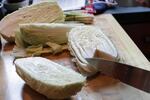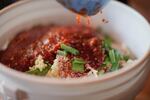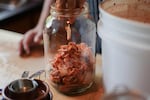
In go Napa cabbage and scallion tops, out comes delicious kimchi.
Laurie Isola / OPB
"In Korea, kimchi is used as a verb," explains Liz Crain, coauthor of "Hello! My Name is Tasty, Global Diner Favorites from Portland's Tasty Restaurants." That sets the pace — this cookbook hits the ground running with soulful dishes for every time of day.
A small team including Crain and John Gorham — chef/owner of Tasty n Sons, Tasty n Alder and other Portland hot spots — spent 10 days on the road exploring Gorham's American Southeast culinary roots, a major influence running through these dishes. Don't be alarmed by all the subrecipes. It's not about fever-dream flavor mash-ups or overwrought presentation.
Crain and Gorham, who also wrote the 2013 "Toro Bravo: Stories. Recipes. No Bull." cookbook, have reached into big-flavored cuisines. When bacon fat and make-your-own whole-grain mustard are suggested staples and handy equipment includes an electric griddle and pressure cooker, you’re in for some dirty-hands and faces meals, reflected in Gorham’s no-b.s. "stay-a-while, taste-this" voice.

Liz Crain and John Gorham — chef/owner of Tasty n Sons, Tasty n Alder and other Portland hot spots — teamed up for "Hello! My Name is Tasty, Global Diner Favorites from Portland's Tasty Restaurants."
Courtesy of Sasquatch Books
Kimchi is an easy dish that stands on its own or can be incorporated into a range of ensemble meal adventures. In the U.S., it typically runs to “bright red Napa cabbage and Daikon radish with chili powder, garlic and fish sauce,” Crain says. “I love the texture and it’s got a whole lot of flavor — crunchy, juicy, sour, spicy, salty.”
Read: 4 Delicious Ways To Use Kimchi
"Any fermenting is like a kitchen experiment. It's fun to watch it evolve, get bubbly, and to taste it every day," says Crain, a co-founder of the annual Portland Fermentation Festival. "You can arrest it when it is exactly to your liking. If you prefer it more robust, use more Korean chili powder or fish sauce."
The microorganisms in this live, fermented food are good for digestion and health overall, she says. And making kimchi at home is cheaper: a pint can run $8 or more at retail. Crain says all ingredients can be found in the Asian aisle at mainstream Portland-area grocery stores or any Asian market (among her favorites are Uwajimaya, Fubonn Shopping Center, An Dong Market and Vieng Lao Oriental Food Center). For fermenting containers, check brew supply stores or specialty shops like Kitchen Kaboodle or Williams Sonoma.
Tasty Kimchi
"We set our fermented kimchi off with tiny salty dried shrimp. A lot of people use raw oysters, but that scares the shit out of me. Whatever you use seafood-wise for your kimchi will basically disintegrate into fish sauce by the time you’ve stopped fermentation. Every now and again, you’ll get a little piece of one of the tiny dried shrimp, but they’re pretty much gone by the time the kimchi gets to the table, especially since we grind ours into a shredded wheat-like consistency. It’s hard to imagine that they get like that when you grind them, but they do.
Do not substitute any other type of chili powder for the Korean chili powder because it’s the perfect balance of sweet, spicy (not too spicy), and smoky. If you used the same amount of cayenne, your kimchi would be crazy fiery, and if you used what Americans call chili powder (which typically includes chili, oregano, cumin, and other herbs and spices), it would be a completely different spice profile.
Also, a little tip: our favorite fish sauce, Red Boat, has a punched-hole lid that doesn’t come off easily, so I usually just bore a hole through that tiny one in the top with a corkscrew (good tip for all different sauces with these lids). Then I don’t have to shake the fish sauce out for three minutes like a dummy.
Yes, a gallon is a lot of kimchi, but it keeps forever when it's refrigerated and it goes well with so many things." — John Gorham
Prep time (excluding fermentation): 10 minutes | Really pretty easy
About 1 gallon
Ingredients
- 5 pounds cored Napa cabbage (2 to 3 whole heads totaling 6 pounds)
- 1/4 cup dried shrimp, ground until it resembles shredded wheat
- 2 cups sambal oelek (a chunky red chili paste)
- 1 cup coarse Korean chili powder
- 1 cup fish sauce (we use Red Boat Fish Sauce)
- 1 cup sliced scallion tops (top three-quarters and not much of the white part from about 2 bunches)
- 1/2 cup light brown sugar
- 3 tablespoons kosher salt
- 2 tablespoons minced garlic
- 2 tablespoons freshly minced ginger
To Prepare
- Halve the cabbages lengthwise and slice each half lengthwise into three pieces. Chop those pieces horizontally into 1-inch strips. Rinse and drain the cabbage.
- In a coffee grinder used exclusively for spices, grind the shrimp until they resemble shredded wheat. Alternatively, you can just mince the shrimp with a knife as finely as possible.
- In a bucket or large bowl, combine all of the ingredients. With clean hands, toss together and massage everything for 2 to 3 minutes, or until all ingredients are fully and evenly incorporated and the cabbage begins to wilt.
- Pack the kimchi tightly into a container large enough to fit 1 gallon with at least a few inches of headspace — either a large, wide glass jar, stoneware crock, or a food-grade bucket — and push it down so that the cabbage is submerged under the bright-red spicy brine, and then top the cabbage with a clean plate or something else that's nonporous that fits inside your vessel. Top the plate with a plastic bag filled with enough water to push the plate down onto the kimchi and seal any gaps. Cover the container with a towel.
- You want the fermenting kimchi to be able to bubble and off-gas as it ferments, but you don't want any air in direct contact with it. The water-filled bag serves both purposes: it weighs down the kimchi and seals all of the gaps of the vessel, thereby keeping air out of and prohibiting any airborne molds from getting into it.
- Ferment the kimchi at room temperature for 5 to 10 days; the longer it ferments, the more tart and pungent it gets. Check on it every day or so (wiping down the inside of the fermentation vessel with a clean towel if there is any sort of buildup when you do so) and make sure that the kimchi is submerged under the spicy brine the entire time. If it comes into contact with air it will get moldy. We typically ferment our kimchi for about 5 days, because I like the flavor and crunch of it at that point, but sample it every couple days until the flavor and texture are to your liking. Store the kimchi in a lidded glass container with its spicy brine in the refrigerator for up to 2 months.
Excerpted from "Hello! My Name is Tasty," copyright 2017 by John Gorham and Liz Crain. Republished with permission from Sasquatch Books.
Liz Crain's Suggestions For Kimchi
- Add to mac and cheese: Once the mac and cheese is baked, nestle kimchi among the rich, chewy, cheesy noodles to add a spicy, bright crunch. For a box mac and cheese, stir in the kimchi along with the milk and butter.
- Toss into a quesadilla, like salsa, to add brightness.
- Mix with fried rice: Heat sesame, canola or peanut oil in a frying pan on the stovetop. Add garlic, ginger, scallions, onions, peas – whatever vegetables you'd like. When cooked through, add the kimchi, cooked and sliced egg, and leftover rice, broken up by hand. (The leftover rice will dry out a bit in the refrigerator overnight so heat it through while separating the kernels and allowing them to brown slightly.) Mix together any combination of soy sauce, hoisin sauce, mirin (rice wine), sesame oil and sugar; stir into the rice, cooking until all the kernels are very lightly coated. Serve hot or at room temperature.
- Use in Korean stew (a great cold-weather comfort food): Find a kimchi jjigae or chigae recipe online or in a Korean cookbook. Ingredients often include scallions and tofu or pork. Ladle the kimchi stew into a bowl and serve with rice.



